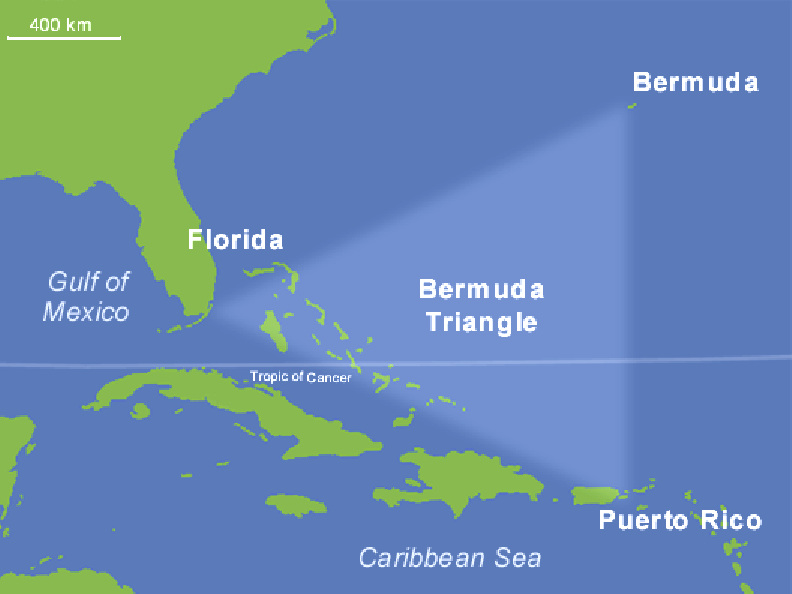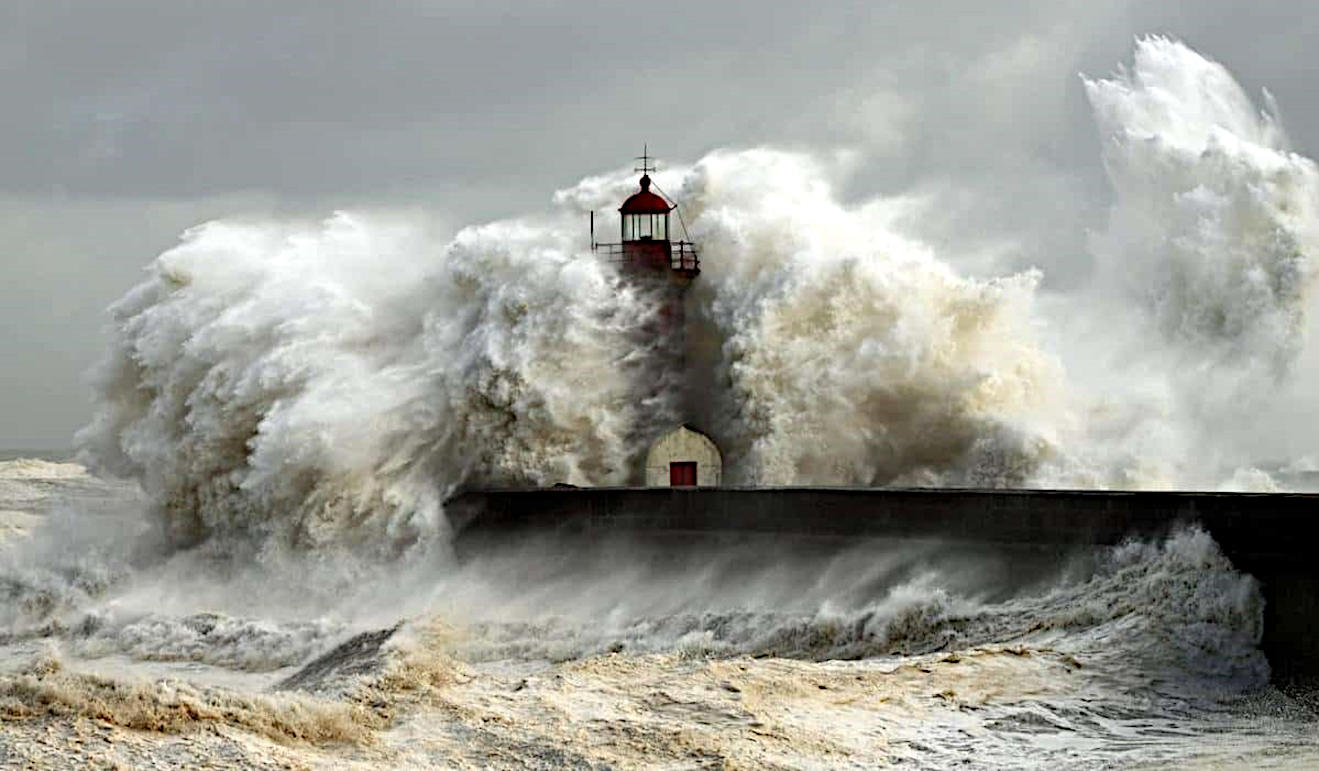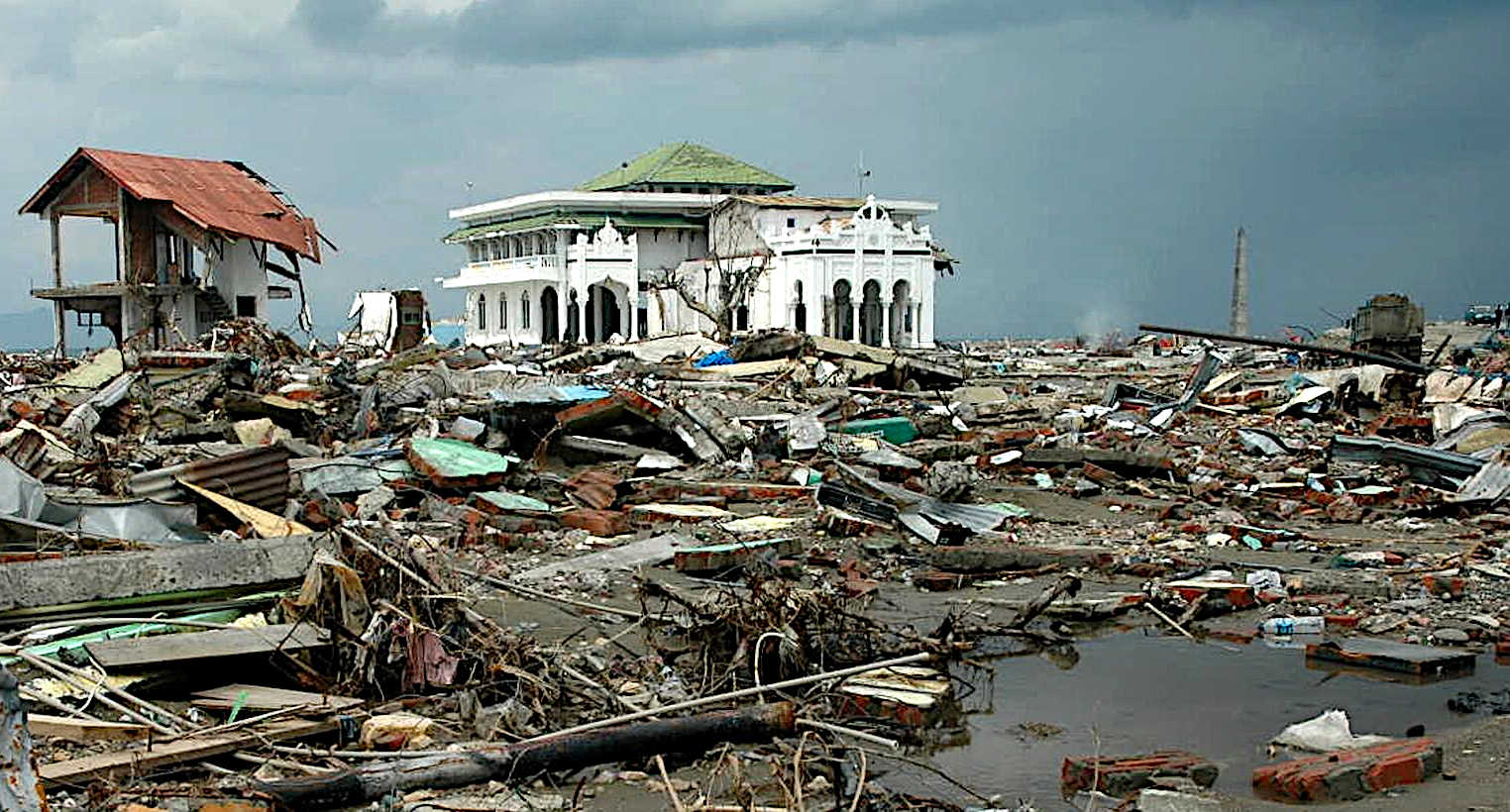
In this fictional John
Storm adventure, Dan
Hawk is petrified of going into, or through the
notorious Bermuda
Triangle. But, John navigates these waters many times
during his ocean and climate awareness adventures, in the
trusty Elizabeth Swann. Though, there have been a few
strange (somewhat magnetic) incidents that none of the crew
can explain. Fortunately, the Swann managed to weather the
stormy conditions that accompanied the instrument glitches.

The Bermuda Triangle, also known as the Devil's Triangle, or Satan's Triangle, is an urban legend focused on a loosely defined region in the western part of the North
Atlantic Ocean where a number of aircraft and ships are said to have disappeared under mysterious circumstances. The idea of the area as uniquely prone to disappearances arose in the mid-20th century, but most reputable sources dismiss the idea that there is any mystery.
The earliest suggestion of unusual disappearances in the Bermuda area appeared in a September 17, 1950, article published in The Miami Herald (Associated Press) by Edward Van Winkle Jones. Two years later, Fate magazine published "Sea Mystery at Our Back Door", a short article by George Sand covering the loss of several planes and ships, including the loss of Flight 19, a group of five US Navy Grumman TBM Avenger torpedo bombers on a training mission. Sand's article was the first to lay out the now-familiar triangular area where the losses took place, as well as the first to suggest a supernatural element to the Flight 19 incident. Flight 19 alone would be covered again in the April 1962 issue of American Legion magazine. In it, author Allan W. Eckert wrote that the flight leader had been heard saying, "We are entering white water, nothing seems right. We don't know where we are, the water is green, no white." He also wrote that officials at the Navy board of inquiry stated that the planes "flew off to Mars."
In February 1964, Vincent Gaddis wrote an article called "The Deadly Bermuda Triangle" in the pulp magazine Argosy saying Flight 19 and other disappearances were part of a pattern of strange events in the region. The next year, Gaddis expanded this article into a book, Invisible Horizons.
Other writers elaborated on Gaddis' ideas: John Wallace Spencer (Limbo of the Lost, 1969, repr. 1973); Charles Berlitz (The Bermuda Triangle, 1974); Richard Winer (The Devil's Triangle, 1974), and many others, all keeping to some of the same supernatural elements outlined by Eckert.
PARANORMAL EXPLANATIONS
Triangle writers have used a number of supernatural concepts to explain the events. One explanation pins the blame on leftover technology from the mythical lost continent of Atlantis. Sometimes connected to the Atlantis story is the submerged rock formation known as the Bimini Road off the island of Bimini in the Bahamas, which is in the Triangle by some definitions. Followers of the purported psychic Edgar Cayce take his prediction that evidence of Atlantis would be found in 1968, as referring to the discovery of the Bimini Road. Believers describe the formation as a road, wall, or other structure, but the Bimini Road is of natural origin.
Some hypothesize that a parallel universe exists in the Bermuda Triangle region, causing a time/space warp that sucks the objects around it into a parallel universe. Others attribute the events to UFOs. Charles Berlitz, author of various books on anomalous phenomena, lists several theories attributing the losses in the Triangle to anomalous or unexplained forces.
COMPASS VARIATIONS
Compass problems are one of the cited phrases in many Triangle incidents. While some have theorized that unusual local magnetic anomalies may exist in the area, such anomalies have not been found. Compasses have natural magnetic variations in relation to the magnetic poles, a fact which navigators have known for centuries. Magnetic (compass) north and geographic (true) north are exactly the same only for a small number of places – for example, as of 2000, in the United States, only those places on a line running from Wisconsin to the
Gulf of
Mexico. But the public may not be as informed, and think there is something mysterious about a compass "changing" across an area as large as the Triangle, which it naturally will.
VIOLENT WEATHER
Hurricanes are powerful storms that form in tropical waters and have historically cost thousands of lives and caused billions of dollars in damage. The sinking of Francisco de Bobadilla's Spanish fleet in 1502 was the first recorded instance of a destructive hurricane. These storms have in the past caused a number of incidents related to the Triangle. Many Atlantic hurricanes pass through the Triangle as they recurve off the Eastern Seaboard, and, before the advent of weather satellite, ships often had little to no warning of a hurricane's approach.
A powerful downdraft of cold air was suspected to be a cause in the sinking of Pride of Baltimore on May 14, 1986. The crew of the sunken vessel noted the wind suddenly shifted and increased velocity from 32 km/h (20 mph) to 97–145 km/h (60–90 mph). A National Hurricane Center satellite specialist, James Lushine, stated "during very unstable weather conditions the downburst of cold
air from aloft can hit the surface like a bomb, exploding outward like a giant squall line of wind and water." A similar event occurred to Concordia in 2010, off the coast of Brazil.
METHANE HYDRATES
An explanation for some of the disappearances has focused on the presence of large fields of methane hydrates (a form of natural gas) on the continental shelves. Laboratory experiments carried out in Australia have proven that bubbles can, indeed, sink a scale model ship by decreasing the density of the
water; any wreckage consequently rising to the surface would be rapidly dispersed by the Gulf Stream. It has been hypothesized that periodic methane eruptions (sometimes called "mud volcanoes") may produce regions of frothy water that are no longer capable of providing adequate buoyancy for ships. If this were the case, such an area forming around a ship could cause it to sink very rapidly and without warning.
Publications by the USGS describe large stores of undersea hydrates worldwide, including the Blake Ridge area, off the coast of the southeastern United States. However, according to the USGS, no large releases of gas hydrates are believed to have occurred in the Bermuda Triangle for the past 15,000 years.

....
NOTABLE INCIDENTS - LOST SHIPS
HMS ATLANTA (ORIGINALLY JUNO)
The sail training ship HMS Atalanta (originally named HMS Juno) disappeared with her entire crew after setting sail from the Royal Naval Dockyard, Bermuda for Falmouth, England on 31 January 1880. It was presumed that she sank in a powerful storm which crossed her route a couple of weeks after she sailed, and that her crew being composed primarily of inexperienced trainees may have been a contributing factor. The search for evidence of her fate attracted worldwide attention at the time (connection is also often made to the 1878 loss of the training ship HMS Eurydice, which foundered after departing the Royal Naval Dockyard in Bermuda for Portsmouth on 6 March), and she was alleged decades later to have been a victim of the mysterious triangle, an allegation resoundingly refuted by the research of author David Francis Raine in 1997.
USS CYCLOPS
The incident resulting in the single largest loss of life in the history of the US Navy not related to combat occurred when the collier Cyclops, carrying a full load of manganese ore and with one engine out of action, went missing without a trace with a crew of 309 sometime after March 4, 1918, after departing the island of Barbados. Although there is no strong evidence for any single theory, many independent theories exist, some blaming storms, some capsizing, and some suggesting that wartime enemy activity was to blame for the loss. In addition, two of Cyclops's sister ships, Proteus and Nereus, were subsequently lost in the North Atlantic during
World War
II. Both ships were transporting heavy loads of metallic ore similar to that which was loaded on Cyclops during her fatal voyage. In all three cases structural failure due to overloading with a much denser cargo than designed is considered the most likely cause of sinking.
CARROL A. DEERING
Carroll A. Deering, a five-masted schooner built in 1919, was found hard aground and abandoned at Diamond Shoals, near Cape Hatteras, North Carolina, on January 31, 1921.
FBI investigation into the Deering scrutinized, then ruled out, multiple theories as to why and how the ship was abandoned, including piracy, domestic Communist sabotage and the involvement of rum-runners.
FLIGHT 19
Flight 19 was a training flight of five TBM Avenger torpedo bombers that disappeared on December 5, 1945, while over the Atlantic. The squadron's flight plan was scheduled to take them due east from Fort Lauderdale for 141 mi (227 km), north for 73 mi (117 km), and then back over a final 140-mile (230-kilometre) leg to complete the exercise. The flight never returned to base. The disappearance was attributed by Navy investigators to navigational error leading to the aircraft running out of fuel.
One of the search and rescue aircraft deployed to look for them, a PBM Mariner with a 13-man crew, also disappeared. A tanker off the coast of Florida reported seeing an explosion and observing a widespread oil slick when fruitlessly searching for survivors. The weather was becoming stormy by the end of the incident. According to contemporaneous sources the Mariner had a history of explosions due to vapour leaks when heavily loaded with fuel, as it might have been for a potentially long search-and-rescue operation.
BSAA STAR TIGER and STAR ARIEL
G-AHNP Star Tiger disappeared on January 30, 1948, on a flight from the Azores to Bermuda; G-AGRE Star Ariel disappeared on January 17, 1949, on a flight from Bermuda to Kingston,
Jamaica. Both were Avro Tudor IV passenger aircraft operated by British South American Airways. Both planes were operating at the very limits of their range and the slightest error or fault in the equipment could keep them from reaching the small island.
DOUGLAS DC-3 1948 AIRBORNE TRANSPORT DISAPPEARANCE
On December 28, 1948, a Douglas DC-3 aircraft, number NC16002, disappeared while on a flight from San Juan, Puerto Rico, to Miami. No trace of the aircraft, or the 32 people on board, was ever found. A Civil Aeronautics Board investigation found there was insufficient information available on which to determine probable cause of the disappearance.
CONNEMARA IV
A pleasure yacht was found adrift in the Atlantic south of Bermuda on September 26, 1955; it is usually stated in the stories (Berlitz, Winer) that the crew vanished while the yacht survived being at sea during three
hurricanes. The 1955 Atlantic hurricane season shows Hurricane Ione passing nearby between 14 and 18 September, with Bermuda being affected by winds of almost gale force. In his second book on the Bermuda Triangle, Winer quoted from a letter he had received from Mr J.E. Challenor of
Barbados:
On the morning of September 22, Connemara IV was lying to a heavy mooring in the open roadstead of Carlisle Bay. Because of the approaching hurricane, the owner strengthened the mooring ropes and put out two additional anchors. There was little else he could do, as the exposed mooring was the only available anchorage. ... In Carlisle Bay, the sea in the wake of Hurricane Janet was awe-inspiring and dangerous. The owner of Connemara IV observed that she had disappeared. An investigation revealed that she had dragged her moorings and gone to sea.
KC-135 STRATOTANKERS
On August 28, 1963, a pair of US Air Force KC-135 Stratotanker aircraft collided and crashed into the Atlantic 300 miles (480 km) west of Bermuda. Some writers say that while the two aircraft did collide there were two distinct crash sites, separated by over 160 miles (260 km) of
water. However, Kusche's research showed that the unclassified version of the Air Force investigation report revealed that the debris field defining the second "crash site" was examined by a search and rescue ship, and found to be a mass of
seaweed and driftwood tangled in an old buoy.
FILM:
SATAN'S TRIANGLE
Satan's Triangle is a 1975 American made-for-television mystery horror film directed by Sutton Roley and produced by ABC. The plot involves a United States Coast Guard helicopter sent to answer a distress call from inside the Bermuda Triangle.
PLOT
USCG pilot Lt Commander Pagnolini and his winchman Haig answer an SOS call at sea and arrive at a derelict schooner, the Requite. Haig lowers himself to the ship, where he finds three dead bodies along with one survivor, Eva, cowering in the cabin.
As the pilot attempts to retrieve Haig and Eva with a rescue basket, the line breaks, plunging the two into the ocean. After they swim back to the boat, the pilot informs Haig that he must return to base because his fuel is borderline. Eva and Haig spend the night on the boat, during which time she recounts the story of the storm that killed everyone else aboard. She explains to him that the strange events began soon after they found a priest drifting in the ocean, apparently a survivor of a disaster. Then, she tells Haig of the violent storm that caused all of the freakish deaths on the boat. One man was hurled through a hatch; one is hanging from the ship's mast; another vanished before her eyes; and a fourth man is in an aft compartment, floating in the air.
Eva attributes the deaths to supernatural causes, but Haig has a practical explanation for everything, including the man who appears to be floating in the air and is actually impaled on a fish's snout. Eva is comforted and has sex with Haig. Early the next morning, the pilot returns along with the Coast Guard cutter Venturous. Haig and Eva are transferred from the Requite to the deck of the Venturous, where they board the helicopter for the flight back to Miami. At the same time, Coast Guard personnel from the Venturous investigate the wrecked schooner.
The story takes a bizarre turn when the Venturous' captain calls Haig to tell him that what they found on the ship was not what Haig reported. The individual hanging from the mast was in fact a woman.
Eva grins evilly and turns into the priest, claims Haig and pushes him out of the helicopter to his death. The priest then turns to Pagnolini and instructs him to beg for salvation, but the pilot rejects the Devil. The priest kills him without touching him and the helicopter crashes into the sea. The priest survives and floats away as we then see Haig come back to life. He waves at a distant ship as it approaches to rescue him, but he has an evil grin on his face.
CAST
Kim Novak as Eva
Doug McClure as Lieutenant J. Haig
Alejandro Rey as Father Peter Martin
Ed Lauter as Strickland
Jim Davis as Hal Bancroft
Michael Conrad as Lieutenant Commander Pagnolini
Titos Vandis as Salao
Zitto Lazann as Juano
Peter Bourne as Swedish Captain
Hank Stohl as Coast Guard Captain Dunnock
Tom Dever as Miami Rescue Radio Officer
Trent Dolan as Miami Rescue Lieutenant
REFERENCES
https://www.


